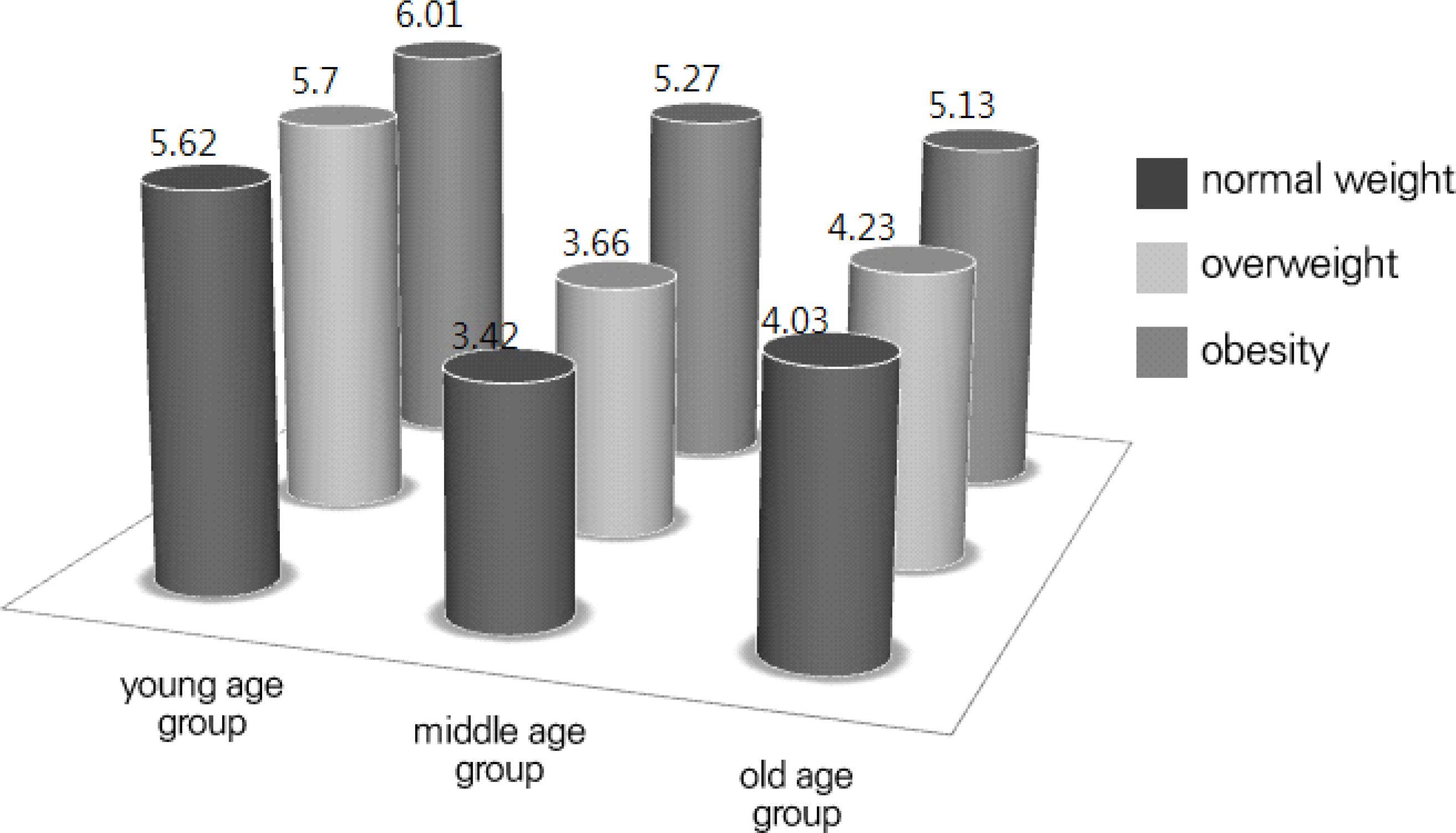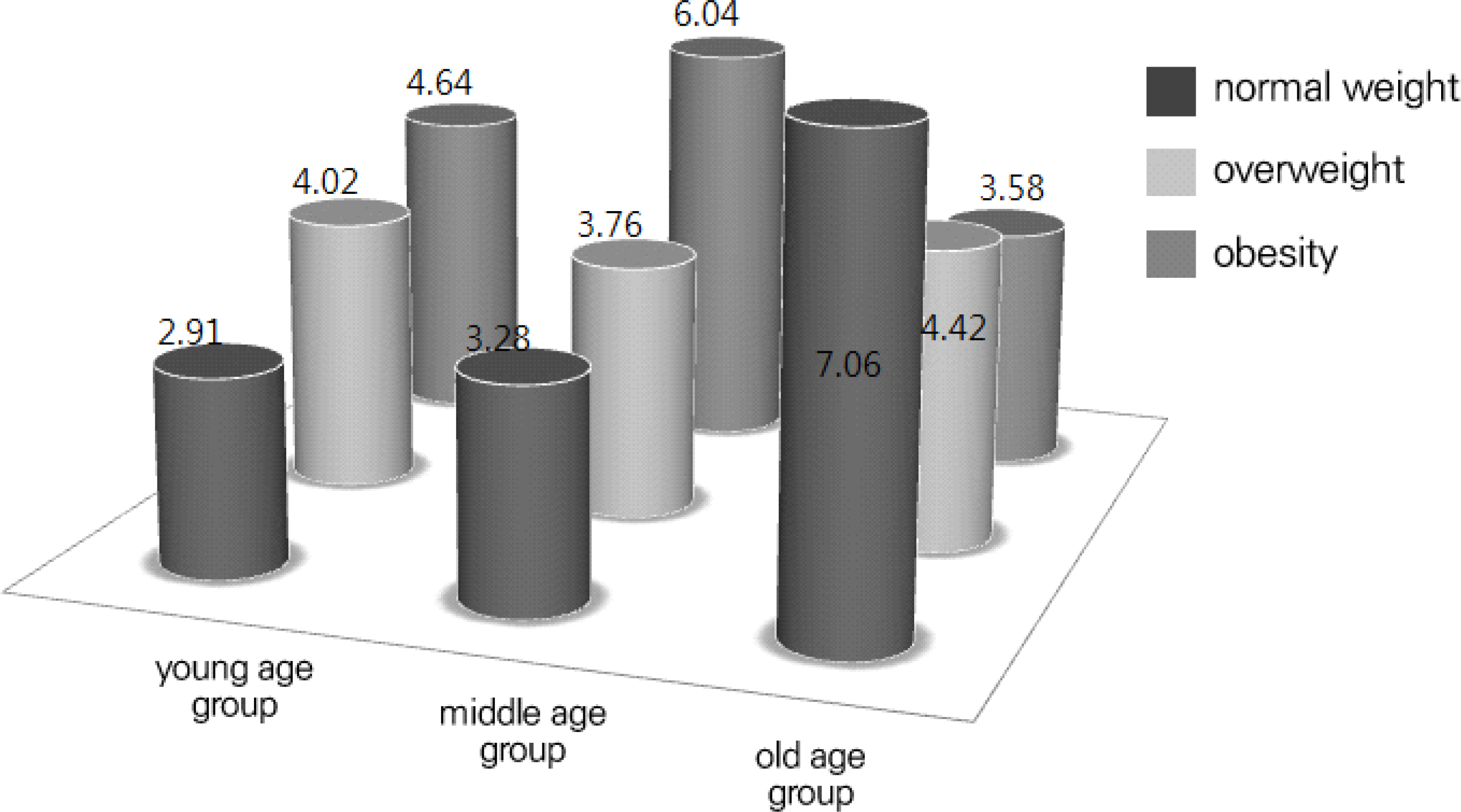Articles
- Page Path
- HOME > Kosin Med J > Volume 31(2); 2016 > Article
-
Original Article
Obesity and Insulin Resistance According to Age in Newly Diagnosed Type 2 Diabetes Patients in Korea - Ju Won Lee, Nam Kyu Kim, Hyun Joon Park, Jun Yeob Lee, Seon Yoon Choi, Eun Mi Lee, So Young Ock, Su Kyoung Kwon, Young Sik Choi, Bu Kyung Kim
-
Kosin Medical Journal 2016;31(2):157-166.
DOI: https://doi.org/10.7180/kmj.2016.31.2.157
Published online: January 20, 2016
Department of Internal Medicine, College of Medicine, Kosin University, Korea
- Corresponding Author: Bu Kyung Kim, Department of Internal Medicine Devision of Endocrinology and Metabolism, College of Medicine, Kosin University, 262, Gamcheon-ro, Seo-gu, Busan 49267, Korea Tel: +82-51-990-6532 Fax: +82-51-990-3065 E-mail: 79kyung@hanmail.net
Copyright © 2016 Kosin University School of Medicine Proceedings
This is an Open Access article distributed under the terms of the Creative Commons Attribution Non-Commercial License (http://creativecommons.org/licenses/by-nc/3.0) which permits unrestricted non-commercial use, distribution, and reproduction in any medium, provided the original work is properly cited.
- 821 Views
- 4 Download
- 1 Crossref
Abstract
-
Objectives
- With the rapid increase in the prevalence of diabetes, the age groups of diabetic patients are becoming diversified. This study will examine the degree of obesity, insulin resistance, and insulin secretion ability among patients first diagnosed with diabetes according to age and gender.
-
Methods
- The subjects of this study included 616 patients who were first diagnosed with diabetes during a routine physical examination. This sample was obtained from a total of 28,075 adults aged 19 years and older who received the examination among 33,829 participants in the Korea National Health & Nutrition Examination Survey (KNHANES) from 2007–2010. The subjects were categorized by age into young age (age: 19 – 39 years), middle age (age: 40 – 59 years), and old age (age: 60 years and older). The degree of obesity was categorized according to body mass index (BMI) into normal weight (BMI: 18.5 ∼ 22.9), overweight (BMI: 23 ∼ 24.9), and obesity (BMI: 25 or above). Insulin resistance was evaluated by homeostatic model assessment of insulin resistance (HOMA-IR).
-
Results
- It was found that 14.1% (n = 87) of a total of 616 subjects (324 men, 292 women) were in the young age group, 43.8% (n = 270) were in the middle age group, and 42.1% (n = 259) were in the old age group. In addition, 83.3% of men that were overweight or obesity were in the young age group, while 79.2% and 60.5% were in the middle age and old age groups, respectively. A total of 82.2% of women that were overweight or obesity were in the young age group, while 79.5% and 77% were in the middle age and old age groups, respectively. For men, the more obesity they were in all age groups, the higher their HOMA-IR. For women, the more obesity they were in the young age and middle age groups, the higher their HOMA-IR; however, women in the old age group showed the highest HOMA-IR when they were of normal weight.
-
Conclusion
- Among diabetic patients first diagnosed with the disease in Korea, the youth population had the highest obesity rate. Insulin resistance increases as an individual's weight increases among those patients who are first diagnosed with diabetes; the only exception noted is for elderly women.


Data are mean ± standard deviation. AC, abdominal circumference; FBS, fasting plasma sugar; HbA1C, hemoglobin A1c; HOMA-IR, [Fasting insulin (IU/mL) × fasting plasma glucose (mmol/L)] / 22.5; HOMA β-cell, [20 × fasting plasma insulin (IU/mL)] / [fasting plasma glucose (mmol/L) – 3.5]; a, young age group and middle age group, P< 0.05; b, young age group and old age group, P< 0.05; c, middle age group and old age group, P< 0.05
- 1. Lam DW, LeRoith D. The worldwide diabetes epidemic. Curr Opin Endocrinol Diabetes Obes 2012;19:93–6.ArticlePubMed
- 2. Kim DJ. The epidemiology of diabetes in Korea. Diabetes Metab J 2011;35:303–8.ArticlePubMedPMC
- 3. Kim JH, Kim DJ, Jang HC, Choi SH. Epidemiology of micro- and macrovascular complications of type 2 diabetes in Korea. Diabetes Metab J 2011;35:571–7.ArticlePubMedPMC
- 4. The Korea Centers for Disease Control and Prevention. Korean National Health and Nutrition Examination Survey. 2009.
- 5. Kim SG, Choi DS. Epidemiology and current status of diabetes in Korea. Hanyang Medical Rev 2009;29:122–9.
- 6. Korean diabetes association. Diabetes fact sheet in Korea. 2012.
- 7. Matthews DR, Hosker JP, Rudenski AS, Naylor BA, Treacher DF, Turner RC. Homeostasis model assessment: insulin resistance and beta-cell function from fasting plasma glucose and insulin concentrations in man. Diabetologia 1985;28:412–9.ArticlePubMed
- 8. Kim KS, Choi CH, Lee DY, Kim EJ. Epidemiological study on diabetes mellitus among rural Korean. J Korean Diabetes Assoc 1972;1:17–24.
- 9. Leahy JL. Natural history of beta-cell dysfunction in NIDDM. Diabetes Care 1990;13:992–1010.PubMed
- 10. Song KE, Kim DJ, Park JW, Cho HK, Lee KW, Hub KB. Clinical Characteristics of Korean Type 2 Diabetic Patients According to Insulin Secretion and Insulin Resistance. J Korean Diabetes Assoc 2007;31:123–9.Article
- 11. Rhee SY, Chon S, Oh S, Kim SW, Kim JW, Kim YS, et al. Insulin secretion and insulin resistance in newly diagnosed, drug naive prediabetes and type 2 diabetes patients with/without metabolic syndrome. Diabetes Res Clin Pract 2007;76:397–403.ArticlePubMed
- 12. DeFronzo RA. Pathogenesis of type 2 diabetes mellitus. Med Clin North Am 2004;88:787–835. ix..ArticlePubMed
- 13. Kahn SE. Clinical review 135. The importance of beta-cell failure in the development and progression of type 2 diabetes. J Clin Endocrinol Metab 2001;86:4047–58.PubMed
- 14. Rhee SY, Kwon MK, Park BJ, Chon S, Jeong IK, Oh ST, et al. Differences in insulin sensitivity and secretory capacity based on OGTT in subjects with impaired glucose regulation. Korean J Intern Med 2007;22:270–4.ArticlePubMedPMC
- 15. Hales CN, Barker DJ. Type 2 (non-insulin-dependent) diabetes mellitus: the thrifty phenotype hypothesis. Diabetologia 1992;35:595–601.ArticlePubMed
References
Figure & Data
References
Citations

- Remote health monitoring services in nursing homes
Jiwon Kim, Hyunsoo Kim, Sungil Im, Youngin Park, Hae-Young Lee, Sookyung Kwon, Youngsik Choi, Linda Sohn, Chulho Oak
Kosin Medical Journal.2023; 38(1): 21. CrossRef

 KOSIN UNIVERSITY COLLEGE OF MEDICINE
KOSIN UNIVERSITY COLLEGE OF MEDICINE



 PubReader
PubReader ePub Link
ePub Link Cite
Cite





